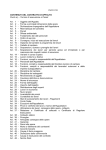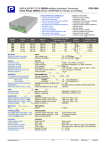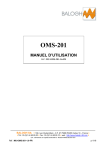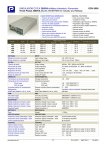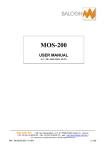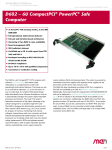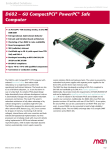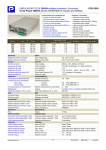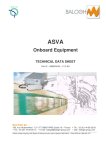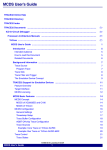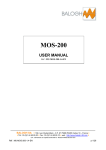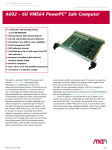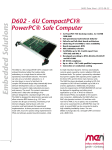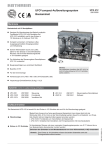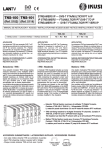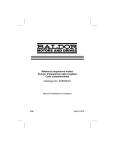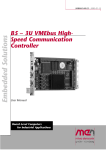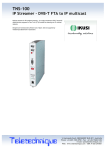Download OMS-201 - Balogh technical center
Transcript
OMS-201 MANUEL D'INTERFACE USER MANUAL Ref : MU-OMS-201-1.6-EN BALOGH SA 189, rue d’Aubervilliers - C.P. 97 75886 PARIS Cedex 18 – France Tél : 33 (0)1 44 65 65 00 Fax : 33 (0)1 44 65 65 10 web : http://www.balogh-rfid.com S.A. à Directoire au Capital de 800 000 € - RCS B PARIS 582 061 073 Ref : MU-OMS-201-1.6-EN p 1/16 OMS-201 TABLE OF CONTENTS 1 2 3 4 5 6 7 FOREWORD ...............................................................................................................................................................3 1.1 AIM OF THIS MANUAL ........................................................................................................................................... 3 1.2 VERSIONS ............................................................................................................................................................. 3 1.3 DISCLAIMER ......................................................................................................................................................... 3 GENERAL INFORMATION.....................................................................................................................................4 2.1 DESCRIPTION OF BRS LOCALISATION SYSTEM ..................................................................................................... 4 2.2 SYSTEM OPERATION ............................................................................................................................................. 5 2.3 SIMPLIFIED DESCRIPTION ...................................................................................................................................... 5 SAFETY RECOMMANDATIONS ...........................................................................................................................6 3.1 MECHANICAL ....................................................................................................................................................... 6 3.2 ELECTRICAL ......................................................................................................................................................... 7 MECHANICAL SPECIFICATION ..........................................................................................................................9 4.1 DIMENSIONS ......................................................................................................................................................... 9 4.2 INSTALLATION DIAGRAMS .................................................................................................................................... 9 4.2.1 Perspective ...................................................................................................................................................... 9 4.2.2 Top view ........................................................................................................................................................ 10 4.2.3 Side view ....................................................................................................................................................... 10 4.2.4 End view........................................................................................................................................................ 10 4.3 POSITIONING CONSTRAINTS FOR BEACON ........................................................................................................... 11 4.4 ENVIRONMENTAL CONSTRAINTS FOR BEACON .................................................................................................... 13 ENCODING OF BEACON IDENTIFIER ...............................................................................................................14 VERIFYING BEACON OPERATION ....................................................................................................................14 6.1 TESTING IN WORKSHOP ....................................................................................................................................... 14 6.1.1 Apparatus required ....................................................................................................................................... 14 6.1.2 Tests to be performed .................................................................................................................................... 15 6.2 VERIFYING THE OPERATION OF AN INSTALLED BEACON .................................................................................... 15 MAINTENANCE ......................................................................................................................................................16 7.1 REGULAR MAINTENANCE .................................................................................................................................... 16 7.2 REPLACEMENT.................................................................................................................................................... 16 7.3 RECYCLING......................................................................................................................................................... 16 BALOGH SA 189, rue d’Aubervilliers - C.P. 97 75886 PARIS Cedex 18 – France Tél : 33 (0)1 44 65 65 00 Fax : 33 (0)1 44 65 65 10 web : http://www.balogh-rfid.com S.A. à Directoire au Capital de 800 000 € - RCS B PARIS 582 061 073 Ref : MU-OMS-201-1.6-EN p 2/16 OMS-201 1 FOREWORD 1.1 Aim of this manual This manual explains how to install and use the OMS-201 beacon. OMS-201 beacon is to be used together with MOS-200 reader. Use of MOS-200 reader is described into user manual MU-MOS-200 1.2 Versions Version Index 1 2 14/07/2010 First English edition, translated from 1.2-FR 1 5 17/12/2010 Translated from 1.5-FR 1 6 06/09/2011 § 3: table index updated 1.3 Date Modifications Manufacturer BALOGH SA, 189 rue d’Aubervilliers, F 75018 Paris, France, is designer and manufacturer of this equipment. This equipment is protected by some patents on behalf of BALOGH SA. 1.4 Disclaimer BALOGH reserves the right to make changes to this manual without further notice. BALOGH does not assume any liability arising out of errors, oversight, or misunderstanding of any information contained in this manual. BALOGH SA 189, rue d’Aubervilliers - C.P. 97 75886 PARIS Cedex 18 – France Tél : 33 (0)1 44 65 65 00 Fax : 33 (0)1 44 65 65 10 web : http://www.balogh-rfid.com S.A. à Directoire au Capital de 800 000 € - RCS B PARIS 582 061 073 Ref : MU-OMS-201-1.6-EN p 3/16 OMS-201 2 GENERAL INFORMATION 2.1 Description of BRS localisation system The Beacon Localisation system consists of: • • an on-board reader mounted under the train ( product code MOS-200) a beacon secured on the ground (product code OMS-201). The reader is composed of a single monolithic unit equipped with a connector (19 pin bayonet lock). The beacon is composed of a single monolithic unit. It communicates by radio-frequency with the reader and has no electrical connection to any ground equipment. On passing over the beacon, the reader remote-powers the beacon and transmits different data via its connector, including a localisation signal when the markings of both casings are vertically aligned Notes: X is the longitudinal track axis (direction of train movement) Y is transversal track axis Z is vertical axis H is the vertical separation between the top of the beacon and the bottom of the reader BALOGH SA 189, rue d’Aubervilliers - C.P. 97 75886 PARIS Cedex 18 – France Tél : 33 (0)1 44 65 65 00 Fax : 33 (0)1 44 65 65 10 web : http://www.balogh-rfid.com S.A. à Directoire au Capital de 800 000 € - RCS B PARIS 582 061 073 Ref : MU-OMS-201-1.6-EN p 4/16 OMS-201 2.2 System operation The reader is powered from the train, typically 110VDC. The beacon is remotely powered by the reader's 125 KHz unmodulated transmitter. Once powered, the beacon transmits at 6.78MHz enabling the reader to generate the localisation signal when the two are vertically aligned. These signals (S1 and S2) are sent to an on-board controller. The beacon also transmits identification data by modulating the 6.78MHz carrier. This identification information is sent on the "Data-TX" interface with transmission speed of 62.5kbits/sec. The other signals shown on the diagram below are used for reader control. 110Vdc Controldu Gestion lecteur Alimentation Power supply 0Vin S1 S2 Localisation Téléalimentation Remote power Identification Pres 125KHz Pres Tag BF Operation) BF (Good (Bon Fonctmt) Cde Test (RS422) Data Tx (RS422) 125KHz 6,78MHz BEACON 2.3 Simplified description As soon as the beacon receives remote power from the reader it starts transmitting its identifier and continues doing so until leaving the reader's field. This identifier is in turn transmitted by the reader on its "Data-TX" interface without interruption until the beacon leaves the reader's field. Either S1 (or S2, depending on the direction of train travel) becomes active on entering the localisation zone and the two signals switch polarities simultaneously when reader and beacon are vertically aligned. On leaving the zone S2 (or S1) becomes inactive. The order (S1 then S2 or S2 then S1) depends on the train's direction of travel. The reader includes a diagnostic function allowing monitoring of the 125 KHz transmitter and data reception. The on-board controller can also communicate with the reader using setup and control commands. BALOGH SA 189, rue d’Aubervilliers - C.P. 97 75886 PARIS Cedex 18 – France Tél : 33 (0)1 44 65 65 00 Fax : 33 (0)1 44 65 65 10 web : http://www.balogh-rfid.com S.A. à Directoire au Capital de 800 000 € - RCS B PARIS 582 061 073 Ref : MU-OMS-201-1.6-EN p 5/16 OMS-201 3 SAFETY RECOMMANDATIONS The safety studies performed on the BRS system (consisting of an on-board reader MOS200 and a ground beacon OMS201), whose main function is to "provide the on-board controller with data allowing localisation of the train", are compliant with the safety requirements SIL 4. The safety manual refers to requirements whose application is the user's responsibility. These requirements are explicitly mentioned in each relevant paragraph below. All the recommendations are summarised in the table below showing the correspondence between the safety manual and the user manuals of (1) MOS-200 reader and (2) OMS-201 beacon (this document). 3.1 Mechanical References in documents Requirements for user Reason MU-MOS-200.EN (reader MOS-200) The metallic environment of the sub-systems must comply with BALOGH SA requirements. A reduced reader-beacon communication range could cause loss of localisation precision. § 6.4 Environmental constraints for reader. The cable-side connector must comply with BALOGH SA requirements. Compatibility (mechanical and electrical) non-compliant with standards and expected requirements. § 7.3 Connector for cable na The cable must comply with BALOGH SA requirements. Compatibility (mechanical and electrical) non-compliant with standards and expected requirements. § 7.4 Type of cable to use. na Connections must be carried out and checked by the user according to BALOGH SA instructions. System operation in non-optimal conditions (protection loss or absence for inputs/outputs against external damage) § 7.4 Type of cable to use. na Fastening of sub-systems must be carried out and checked by the user according to BALOGH SA instructions. A reduced reader-beacon communication range could cause loss of localisation precision. Data transmission to controller at the wrong moment. § 5.1 Mechanical specifications § 5.1 Mechanical specifications Positioning of sub-systems in axes X, Y & Z must be carried out and checked by the user according to BALOGH SA instructions. A reduced reader-beacon communication range could cause loss of localisation precision. Data transmission to controller at the wrong moment. § 6.3 Positioning constraint for reader. § 6.2 Positioning constraint for beacon. Instructions for operation provided by BALOGH SA guaranteeing radio communication must be carried out by the user. A reduced reader-beacon communication range could cause loss of localisation precision. § 6.3 Positioning constraint for reader. § 6.2 Positioning constraint for beacon. MU-OMS-201.EN (beacon OMS-201) § 6.3 Environmental constraints for beacon. Note: na = not applicable BALOGH SA 189, rue d’Aubervilliers - C.P. 97 75886 PARIS Cedex 18 – France Tél : 33 (0)1 44 65 65 00 Fax : 33 (0)1 44 65 65 10 web : http://www.balogh-rfid.com S.A. à Directoire au Capital de 800 000 € - RCS B PARIS 582 061 073 Ref : MU-OMS-201-1.6-EN p 6/16 OMS-201 3.2 Electrical References in documents Requirements for user Reason MU-MOS-200.EN (reader MOS-200) MU-MOS-200.EN (reader MOS-200) 110VDC power provided by train must comply with requirements specified by BALOGH SA. Non-safety recommendation. No system operation § 8.2 Power supply na User must take necessary precautions in order to avoid incorrect encoding of ground beacon. A wrong ground beacon identifier will be transmitted "as is" to the on-board controller na § 7 Encoding of beacon identifier. At the controller, the user must provide a means of extracting the beacon identifier from a continuous data stream transmitted from the BRS system through the Data-TX interface and a means of checking data transmission integrity for this identifier. The BRS system performs no checking of data transmission integrity (signals: RS422_Data Tx+ & RS422_Data Tx-). § 11 Identification Interface "Data-TX". na At the controller, the user must provide a means of checking coherence for signals S1 & S2 by examining their change of state and a means of determining the localisation instant The BRS system performs no checking of localisation information (signals: TOR_S1 & TOR_S2) § 10 Localisation Signals na The user must use all the safety data (DataTX, S1 & S2) provided by the BRS system in order to perform the train localisation function. Necessary operating conditions providing a guaranteed Safety Integrity Level SIL4 for the BRS system. § 10 Localisation Signals na Note: na = not applicable BALOGH SA 189, rue d’Aubervilliers - C.P. 97 75886 PARIS Cedex 18 – France Tél : 33 (0)1 44 65 65 00 Fax : 33 (0)1 44 65 65 10 web : http://www.balogh-rfid.com S.A. à Directoire au Capital de 800 000 € - RCS B PARIS 582 061 073 Ref : MU-OMS-201-1.6-EN p 7/16 OMS-201 4 TECHNICAL SPECIFICATIONS min nominal max unit Radiofrequency communication Carrier frequency SN 6.78 Reading range ∆z (with MOS200 reader) 60 MHz 200 mm Memory Technology EEPROM Memory capacity 512 Data rate TD - 62.5 Kbit/s Time delay before availability (start-up time) 5 Number of reading unlimited Data retention bits ms - 10 years Environment Operating temperature -25 +70 °C Storage temperature -40 +85 °C EMC according to EN 50121-4 compliant - Radio according to EN 300 330 compliant - mounting on sleepers - Sun radiance according to CEI 60068-2-5 1120 W/m Altitude according to EN 60068-2-13 1200 m Coldness according to EN 60068-2-1 -25 °C Dry heat according to EN 60068-2-2 +70 °C Moist heat cycle according to EN 60068-2-30 +55 °C Fire & smoke rating according to NF-F16101 & NF-F16102 I3F2 - Protection rating accoding to EN 60529 IP 67 - 100 mm 1200 g Material (external) PA 6 (polyamid 6) - Molding (internal) PU (polyurethan) - 5 Nm Shocks and vibrations according to EN 50125-3 Under-ice operating warranty 2 Enclosure Weight Recommended tightening torque (4 screws Ø 6mm) BALOGH SA 189, rue d’Aubervilliers - C.P. 97 75886 PARIS Cedex 18 – France Tél : 33 (0)1 44 65 65 00 Fax : 33 (0)1 44 65 65 10 web : http://www.balogh-rfid.com S.A. à Directoire au Capital de 800 000 € - RCS B PARIS 582 061 073 Ref : MU-OMS-201-1.6-EN p 8/16 OMS-201 5 MECHANICAL SPECIFICATION 5.1 Dimensions Dimensions of bare casing: • Length = 240 mm • Width = 80mm • Height = 42mm SAFETY RECOMMENDATION – SIL4 Fastening of sub-systems must be carried out and checked by the user according to BALOGH SA instructions. The beacon is fastened using 4 screws Ø 6mm. Recommended tightening torque is 5Nm. 5.2 Installation diagrams 5.2.1 Perspective BALOGH SA 189, rue d’Aubervilliers - C.P. 97 75886 PARIS Cedex 18 – France Tél : 33 (0)1 44 65 65 00 Fax : 33 (0)1 44 65 65 10 web : http://www.balogh-rfid.com S.A. à Directoire au Capital de 800 000 € - RCS B PARIS 582 061 073 Ref : MU-OMS-201-1.6-EN p 9/16 OMS-201 5.2.2 Top view 5.2.3 Side view 5.2.4 End view BALOGH SA 189, rue d’Aubervilliers - C.P. 97 75886 PARIS Cedex 18 – France Tél : 33 (0)1 44 65 65 00 Fax : 33 (0)1 44 65 65 10 web : http://www.balogh-rfid.com S.A. à Directoire au Capital de 800 000 € - RCS B PARIS 582 061 073 Ref : MU-OMS-201-1.6-EN p 10/16 OMS-201 6 INSTALLATION SPECIFICATIONS 6.1 Environmental conditions The following environmental conditions must apply : • • • • • 6.2 Storage temperature : -40°C to +85°C Operating temperature : -25°C to +70°C Maximum relative humidity : 100% Installation on sleepers : according to EN50125-3 Electromagnetic environment : according to EN50121-4 standard. However it is recommended to verify proximity of other equipments using radio-electrical waves at same or similar frequencies. In this case it would be necessary to verify functionality by means of compatibility tests. Positioning constraints for beacon • • • • SAFETY REQUIREMENT – SIL4 CONTRAINTE DE SECURITE – SIL4 Positioning of sub-systems in axes X, Y & Zêtre Les fixations des sous-systèmes doivent must be carried out and checked by the assurées et contrôlées par l’utilisateur,user selon according to BALOGH SAle instructions des consignes émis par constructeur. The beacon must be installed transversally (long side of casing perpendicular to track). The reference axis for localisation is engraved on the casing and is 22 mm off-centre. By taking this offset into account, the beacon can be installed in either position.. The vertical separation H between the bottom of the reader and the top of the beacon must be between 60mm and 200mm BALOGH SA 189, rue d’Aubervilliers - C.P. 97 75886 PARIS Cedex 18 – France Tél : 33 (0)1 44 65 65 00 Fax : 33 (0)1 44 65 65 10 web : http://www.balogh-rfid.com S.A. à Directoire au Capital de 800 000 € - RCS B PARIS 582 061 073 Ref : MU-OMS-201-1.6-EN p 11/16 OMS-201 6.2.1 Positioning operational tolerances : Tolerances for each reader vs each beacon ∆Y Lateral offset (see notes hereunder) +/- 50mm ΘX Tilt in vertical (lateral) plane +/- 10° ΘY Tilt in vertical (longitudinal) plane +/- 15° ΘZ Rotation in horizontal plane (top view) +/- 5° 6.2.2 Notes about operational tolerances: • • The position and angular tolerances for each reader-beacon pair must be met. In order to achieve this end, the tolerances for an individual beacon (or reader) can be relaxed. These tolerances are additive: a reader-beacon pair with all tolerances at their maximum values will operate correctly. 6.2.3 Notes about lateral offset tolerance : • • • The maximum lateral offset for correct operation is +/- 50mm. Within this interval product performance is guaranteed. The maximum lateral offset for functional operation is +/- 80mm. At this offset, communication and localisation are possible, however without guaranteed performance (in particular for precision). Tolerances shown in the table must be adhered to during installation so that performance is maintained during movement given that small deviations (vibrations…) occur. BALOGH SA 189, rue d’Aubervilliers - C.P. 97 75886 PARIS Cedex 18 – France Tél : 33 (0)1 44 65 65 00 Fax : 33 (0)1 44 65 65 10 web : http://www.balogh-rfid.com S.A. à Directoire au Capital de 800 000 € - RCS B PARIS 582 061 073 Ref : MU-OMS-201-1.6-EN p 12/16 OMS-201 6.3 Metallic environment constraints for beacon SAFETY REQUIREMENT – SIL4 CONTRAINTE DE SECURITE – SIL4 The metallic environment of the sub-systems Les fixations des sous-systèmes doivent être must comply BALOGH requirements. assurées et with contrôlées parSA l’utilisateur, selon des consignes émis par le constructeur. • The distance between two beacons must be greater than 2.50 meters (250 cm). • The beacon must be centrally fixed on a metallic plate of dimensions 260mm x 180mm or greater. Choosing of metal (steel, alu, stainless steel…) and thickness of plate only depend of solidity and environment constraints Such a plate is available as an accessory (BALOGH P/N: PLA2618/OMS). • There must be a metal-free zone around the beacon as indicated in the diagram below (colour = zone without metal) : Cross section (across track): METAL-FREE ZONE Metallic backplate Cross section (along track): METAL-FREE ZONE Metallic backplate BALOGH SA 189, rue d’Aubervilliers - C.P. 97 75886 PARIS Cedex 18 – France Tél : 33 (0)1 44 65 65 00 Fax : 33 (0)1 44 65 65 10 web : http://www.balogh-rfid.com S.A. à Directoire au Capital de 800 000 € - RCS B PARIS 582 061 073 Ref : MU-OMS-201-1.6-EN p 13/16 OMS-201 7 ENCODING OF BEACON IDENTIFIER SAFETY REQUIREMENT – SIL4 CONTRAINTE DE SECURITE – SIL4 User must take necessary precautions in order Les fixations des sous-systèmes doivent être to avoid incorrect encoding ground beacon . assurées et contrôlées parof l’utilisateur, selon des consignes émis par le constructeur. The beacon identifier is a code stored in the beacon's internal memory. The encoding of this identifier must be done with a special tool, in the workshop before installation. This encoding tool can be obtained from BALOGH (order code LPF-2629-OMS). Please consult the relevant user manual for a description of its use. The encoding procedure of the beacon identifier must be performed by the user. The encoding tool checks the code which is stored, however for security reasons, a separate verification using an independent reader is recommended. To this end, a portable reader can be obtained from BALOGH (order code LP-1712-OMS). This portable reader does not allow modification of the beacon identifier, only its display. Please consult the relevant user manual for a description of its use. This verification can also be performed with a MOS-200 reader. 8 VERIFYING BEACON OPERATION Beacon verification can be done in two cases: - In the workshop, for example on delivery or before installation. In this case measurements can be made using a reference reader MOS-200 and several different apparatus. A test cable can be used to connect to this reader in order to monitor the signals and a PC can be used to emulate the on-board controller. - Beacon installed on the track, for regular checks. The OMS-201 beacon is entirely immersed in resin. It can neither be disassembled nor repaired. Any permanent fault or defect found during the verification process will require the beacon to be replaced. The technical procedures described in this chapter need to be carried out by personnel adequately trained in electronics measurements. 8.1 Testing in workshop 8.1.1 Apparatus required - A MOS-200 reference reader mounted on a metallic plate of dimensions 385mm x 296mm or greater. A test cable with 19-pin female plug and individual access to all 19 wires Power supply 110V / 1A A 2-channel oscilloscope. If not available, either two voltmeters or a circuit with LEDS for visualising the digital outputs can be used A metallic plate of dimensions 260mm x 180mm on which the beacon under test is to be fixed. A test tool (OTGM) which includes all necessary interfaces for the test can be purchased directly at BALOGH SA. Contact commercial team. BALOGH SA 189, rue d’Aubervilliers - C.P. 97 75886 PARIS Cedex 18 – France Tél : 33 (0)1 44 65 65 00 Fax : 33 (0)1 44 65 65 10 web : http://www.balogh-rfid.com S.A. à Directoire au Capital de 800 000 € - RCS B PARIS 582 061 073 Ref : MU-OMS-201-1.6-EN p 14/16 OMS-201 8.1.2 Tests to be performed - The MOS-200 reader is connected to the 110VDC power supply, When no beacon is present. o signal BF must be at 1 o signal Pres125KHz must be at 1 - The beacon is placed before the reader o signal Pres6.78KHz becomes active (1) - Move the beacon past the reader simulating the train movement o signals S1 and S2 must behave as follows : X X’ S1 S2 Start/end of Communication zone - Start/end of Beacon Localisation Communication zone By connecting the serial link "CDE-TEST" to a PC using an RS422-RS232 converter (see connection diagram below), the "MOS-Cde-Test" program can be used to read the beacon identifier. Converter RS422/232 RX+ PC RXTX+ A B Y Z P V R C TX- - 8.2 READER CdeTest_RS422_TX+ CdeTest_RS422_TXCdeTest_RS422_RX+ CdeTest_RS422_RX- Signal "DATA-TX" can be checked with an oscilloscope: signal is present and data rate is 62.5 kbits/s (bit duration of 16µs). Verifying the operation of an installed beacon The LP-1712-OMS portable reader can verify correct beacon encoding by displaying its identifier. Please consult the relevant user manual for a description of its use. A MOS-200 reader can also be used to verify correct operation. In this case it is the user's responsibility to implement the necessary test functions in the controller or PC, for example, displaying the beacon identifier. BALOGH SA 189, rue d’Aubervilliers - C.P. 97 75886 PARIS Cedex 18 – France Tél : 33 (0)1 44 65 65 00 Fax : 33 (0)1 44 65 65 10 web : http://www.balogh-rfid.com S.A. à Directoire au Capital de 800 000 € - RCS B PARIS 582 061 073 Ref : MU-OMS-201-1.6-EN p 15/16 OMS-201 9 MAINTENANCE 9.1 Regular maintenance The OMS-201 beacon requires no regular operational maintenance. The OMS-201 beacon should be regularly cleaned to avoid accumulation of dirt on casing. The OMS-201 beacon should be regularly examined for: • • • • cracks in casing broken mounting plates missing mounting screws correctly tightened mounting screws The OMS-201 beacon operation should be checked regularly according to procedure in the previous chapter. 9.2 Replacement To replace an OMS-201 beacon, proceed as follows: - Remove the 4 mounting screws and lift out the beacon, remembering the localisation axis. Put the new beacon in the same position, replace the 4 mounting screws and tighten to recommended torque. Check for correct operation according to above procedure in the previous chapter. 9.3 Recycling Decommissioned OMS-201 readers should be returned to BALOGH for recycling in accordance with guideline D3E. BALOGH SA 189, rue d’Aubervilliers - C.P. 97 75886 PARIS Cedex 18 – France Tél : 33 (0)1 44 65 65 00 Fax : 33 (0)1 44 65 65 10 web : http://www.balogh-rfid.com S.A. à Directoire au Capital de 800 000 € - RCS B PARIS 582 061 073 Ref : MU-OMS-201-1.6-EN p 16/16
















